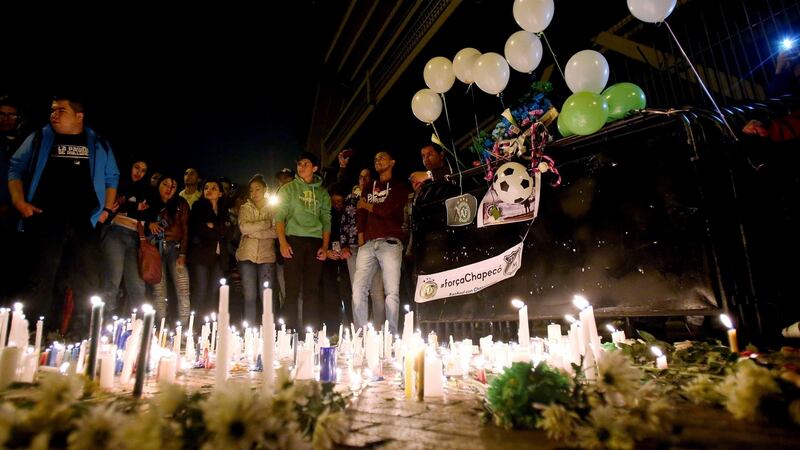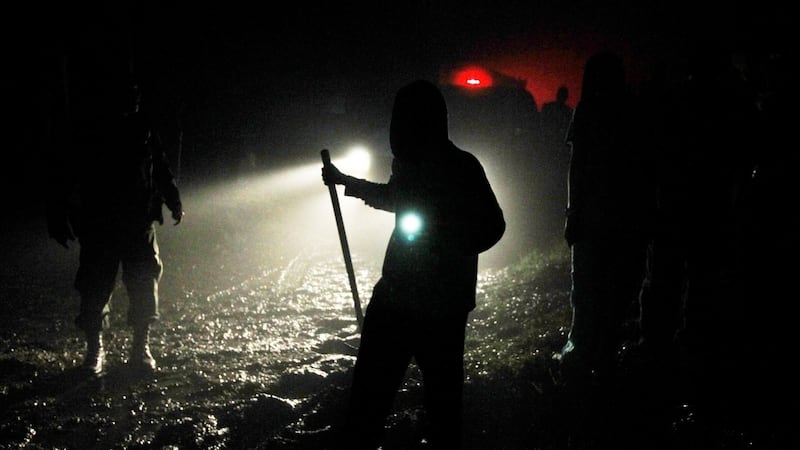Colombian authorities are searching for answers after a charter plane carrying a football team crashed into Colombia’s Andes mountains, killing all but six of the 77 people on board.
The British Aerospace 146 short-haul plane’s crew declared an emergency and lost radar contact just before 10pm local time on Monday (3am Irish time on Tuesday), according to Colombia’s aviation agency. It said the plane’s black boxes had been recovered and were being analysed.
The aircraft, which departed from Santa Cruz, Bolivia, was carrying the Chapecoense team from southern Brazil for Wednesday's first leg of the two-game Copa Sudamericana final against Atletico Nacional of Medellin. Twenty-one Brazilian journalists were also on board.


Colombian officials initially said the plane suffered an electrical failure but there was also heavy rain at the time of the crash.
Authorities also said they were not ruling out the possibility, relayed to rescuers by a surviving flight attendant, that the plane ran out of fuel minutes before its scheduled landing at Jose Maria Cordova airport outside Medellin.
The emotional pain of Colombia’s deadliest air tragedy in two decades was felt across the football world.
Expressions of grief poured in as South America's federation cancelled all scheduled matches in a show of solidarity, Real Madrid's squad interrupted its training for a minute of silence and Argentine legend Diego Maradona sent his condolences to the victims' families on Facebook.
Brazil’s top teams offered to loan the small club players next season so they can rebuild following the sudden end to a fairytale season that saw Chapecoense reach the final of one of South America’s most prestigious regional tournaments just two years after making it into the first division for the first time since the 1970s.
“It is the minimum gesture of solidarity that is within our reach,” the teams said in a statement.
Sportsmanship also prevailed, with Atletico Nacional asking that the championship title be given to its rival, whose upstart run had electrified football-crazy Brazil.
Helicopters grounded
Rescuers working through the night were initially heartened after pulling three people alive from the wreckage. But as the hours passed, heavy fog and stormy weather grounded helicopters and slowed efforts to reach the crash site.
At daybreak, dozens of bodies scattered across a muddy mountainside were collected into white bags.
They were then loaded on to several Black Hawk helicopters that had to perform a tricky manoeuvre to land on the crest of the Andes mountains.
The plane’s fuselage appeared to have broken into two, with the nose facing downward into a steep valley.
Officials initially reported 81 people were on board the flight, but later revised that to 77, saying four people on the flight manifest did not board the plane.
Three players were among the survivors. Alan Ruschel was reported in the most serious condition, facing surgery for a spinal fracture. Teammates Helio Zampier and Jakson Follmann also suffered multiple injuries, and doctors had to amputate Follmann’s right leg.
A journalist also underwent surgery and two Bolivian crew members were in a stable condition, hospital officials said.
The aircraft is owned by LaMia, a charter company that started off in Venezuela but later relocated to Bolivia, where it was certified to operate last January. Despite such apparently limited experience the airline has a close relationship with several premier South American squads.
Earlier this month, the plane involved in the crash transported Barcelona forward Lionel Messi and the Argentina national team from Brazil following a World Cup qualifier match.
The airliner also appears to have transported the national squads of Brazil, Bolivia and Venezuela over the last three months, according to a log of recent activity provided by Flightradar24.com.
Before being taken offline, LaMia’s website said it operated three 146 Avro short-haul jets made by British Aerospace, with a maximum range of around 1,600 nautical miles — about the same as the distance between Santa Cruz and Medellin.
‘Cutting it close’
Hans Weber, an adviser to US aviation authorities, said the air distance between cities was usually measured by the shortest route but planes rarely flew in a straight line — pilots may steer around turbulence or change course for other reasons.
Given the model of the plane and that it was flying close to capacity “I would be concerned that the pilots may have been cutting it too close”, Mr Weber said.
Bolivia's civil aviation agency said the aircraft picked up the Brazilian team in Santa Cruz, where the players had arrived on a commercial flight from Sao Paulo. Spokesman Cesar Torrico said the plane underwent an inspection before departing for Colombia and reported no problems.
“We can’t rule out anything. The investigation is ongoing and we’re going to await the results,” said Gustavo Vargas, a retired Bolivian air force general who is president of the airline.
Colombian authorities hope to interview the Bolivian flight attendant who relayed the fuel concerns on Wednesday.
Moments before the flight departed, the team’s coaching staff gave an interview praising the airline, saying it brought them good fortune when it flew them to Colombia last month for the championship’s quarter-finals, which they won.
The team, from the small Brazilian agro-industrial city of Chapeco, was in the midst of a breakout season advancing last week to the Copa Sudamericana finals after defeating some of the region’s top sides, including Argentina’s San Lorenzo and Independiente, as well as Colombia’s Junior.
Chapecoense were so modest that tournament organisers ruled its 22,000-seat arena was too small to host the final match, which was moved to a stadium 300 miles to the north, in the city of Curitiba.
The team won over fans across Brazil with its spectacular run, with some even taking up a campaign online to move the final match to Rio de Janeiro’s iconic Maracana stadium, where the 2014 World Cup finals were played.
AP








